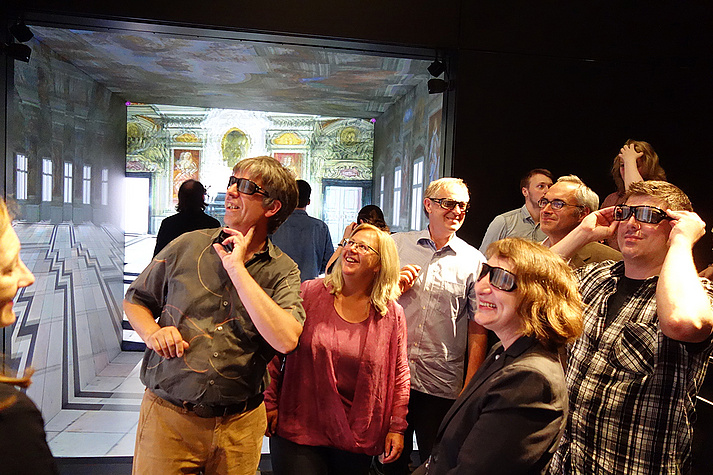3D models in the CAVE of the LRZ
Date: 27.6.2016
Time: 13:00 to 16:00 h
Location: Center for Virtual Reality and Visualization (V2C) of the Leibniz Computing Center (LRZ) in Garching, Boltzmannstraße 1.
On June 27, 2016, the Academy project "Corpus of Baroque Ceiling Painting in Germany" presented the results of a pilot project "Baroque Ceiling Painting and 3D" in the CAVE of the Center for Virtual Reality and Visualization (V2C) of the Leibniz Computing Center in Garching. Two 3D models of baroque interiors could be virtually walked through and viewed there by a selected group of participants: the Chamber Chapel of the Electress in the New Palace Schleißheim and the Imperial Hall of the New Residence in Bamberg.
The 3D models were created in very different ways and yet were similarly impressive. The digital model of the Schleißheim Chamber Chapel was produced by students at LMU Munich as part of two parallel courses held in the winter semester 2015/16: the seminars "Baroque Palaces in the Munich Area. Possibilities of their Visualization with the New Media" by PD Dr. Ute Engel, Institute of Art History and Corpus Ceiling Painting, and "3D Software in Creative Processes" by Dr. Karin Guminski, Art and Multimedia Program, Institute of Art Education. The 3D modeling of the Bamberg Kaisersaal was developed by Bernhard Strackenbrock from the company "illustrated Architecture", a guest scientist at the German Aerospace Center in the team of Prof. Gerd Hirzinger, in cooperation with the ceiling painting project.
The presentation in the CAVE was followed by a lively discussion about the results and potentials of such virtual modeling: IT experts from the LRZ, the BAdW, or the new Competence Center for Monument Sciences and Technologies (KDWT) at the Otto-Friedrich-University Bamberg exchanged ideas with young scientists from the seminars, lecturers from the LMU, representatives of the Bavarian Palace Department and the team of the Ceiling Painting Project led by Prof. Dr. Stephan Hoppe.
Program
Introduction by Dr. Christoph Anthes (V2C), Prof. Dr. Stephan Hoppe, and PD Dr. Ute Engel (Institute for Art History, LMU Munich)
I. The Chamber Chapel of the Electress in the New Schleißheim Palace as a 3D model:
Introduction by Dr. Karin Guminski (Head of Art and Multimedia, Institute for Art Education, LMU) and Michael Käsdorf.
Guided tour in the CAVE in groups
II. the Kaisersaal in the Neue Residenz Bamberg as a 3D model:
Introduction by Bernhard Strackenbrock illustrated architecture, and guest scientist at the German Aerospace Center.
Inspection in the CAVE in groups
III. Discussion
We ask for registration under: ute.engel@kunstgeschichte.uni-muenchen.de
3D-Modelle in der CAVE des LRZ

Datum: 27.6.2016
Uhrzeit: 13:00 bis 16:00 Uhr
Ort: Zentrum für Virtuelle Realität und Visualisierung (V2C) des Leibniz-Rechenzentrums (LRZ) in Garching, Boltzmannstraße 1
Am 27. Juni 2016 präsentierte das Akademieprojekt „Corpus der barocken Deckenmalerei in Deutschland“ die Ergebnisse eines Pilotprojekts „Barocke Deckenmalerei und 3D“ in der CAVE des Zentrums für Virtuelle Realität und Visualisierung (V2C) des Leibniz-Rechenzentrums in Garching. Zwei 3D-Modelle barocker Innenräume konnten dort von einem ausgewählten Kreis von TeilnehmerInnen virtuell durchschritten und betrachtet werden: die Kammerkapelle der Kurfürstin im Neuen Schloss Schleißheim und der Kaisersaal der Neuen Residenz in Bamberg.
Die 3D-Modelle entstanden auf ganz unterschiedliche Weise und waren doch ähnlich eindrucksvoll. Das digitale Modell der Schleißheimer Kammerkapelle produzierten Studierende der LMU München im Rahmen von zwei parallelen Lehrveranstaltungen, die im Wintersemester 2015/16 durchgeführt wurden: die Seminare „Barocke Schlösser im Münchner Raum. Möglichkeiten ihrer Visualisierung mit den neuen Medien“ von PD Dr. Ute Engel, Institut für Kunstgeschichte und Corpus Deckenmalerei, sowie „3D-Software in kreativen Prozessen“ von Dr. Karin Guminski, Studiengang Kunst und Multimedia, Institut für Kunstpädagogik. Die 3D-Modellierung des Bamberger Kaisersaals entwickelte Bernhard Strackenbrock von der Firma „illustrated architecture“, Gastwissenschaftler am Deutschen Zentrum für Luft- und Raumfahrt im Team Prof. Gerd Hirzinger, in Zusammenarbeit mit dem Deckenmalerei-Projekt.
Im Anschluss an die Präsentation in der CAVE fand eine lebhafte Diskussion über die Ergebnisse und Potentiale solcher virtuellen Modellierungen statt: IT-Experten des LRZ, der BAdW oder des neuen Kompetenzzentrums für Denkmalwissenschaften und-technologien (KDWT) an der Otto-Friedrich-Universität Bamberg tauschten sich mit dem wissenschaftlichen Nachwuchs aus den Seminaren, den DozentInnen der LMU, Vertretern der Bayerischen Schlösserverwaltung und dem Team des Deckenmalerei-Projekts unter der Leitung von Prof. Dr. Stephan Hoppe aus.
Programm
Einführung durch Dr. Christoph Anthes (V2C), Prof. Dr. Stephan Hoppe und PD Dr. Ute Engel (Institut für Kunstgeschichte, LMU München)
I. Die Kammerkapelle der Kurfürstin im Neuen Schloss Schleißheim als 3D-Modell:
Einführung durch Dr. Karin Guminski (Studiengangsleiterin Kunst und Multimedia,Institut für Kunstpädagogik, LMU) und Michael Käsdorf
Begehung in der CAVE in Gruppen
II. Der Kaisersaal in der Neuen Residenz Bamberg als 3D-Modell:
Einführung durch Bernhard Strackenbrock, illustrated architecture, und Gastwissenschaftler am Deutschen Zentrum für Luft- und Raumfahrt
Begehung in der CAVE in Gruppen
III. Diskussion
Wir bitten um Anmeldung unter: ute.engel@kunstgeschichte.uni-muenchen.de
